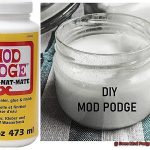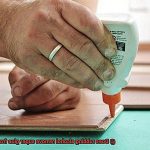Mold – the sneaky culprit that can grow on anything and everything, causing damage to our belongings and health. It’s essential to be cautious and vigilant in keeping our homes and workplaces mold-free. But have you ever pondered if mold could grow on glue? We use glue for countless purposes, from sticking papers to fixing broken objects. So, it’s crucial to know whether this everyday household item can harbor the growth of mold.
Warm, dark, and moist environments are a breeding ground for mold. Therefore, it’s logical to assume that glue, which contains water and is often found in damp areas, could also be susceptible to mold growth. However, the answer isn’t as straightforward as we might think – it depends on various factors such as the type of glue used, surrounding environment, and frequency of usage.
In this blog post, we’ll delve into the nitty-gritty details of whether mold can grow on glue and explore the reasons behind it. We’ll also provide tips on preventing mold growth on your favorite adhesive products and how to get rid of any existing mold. So buckle up and read on to discover if your beloved glue may be hiding a toxic secret.
What is Glue?
Contents
Glue is not just a common household item but it’s also a fascinating substance that plays an essential role in our daily lives. From crafting to construction, it’s used to bond materials together and comes in various forms such as liquid, paste, or tape. The main purpose of glue is to create a strong and lasting bond between two or more surfaces, making it an indispensable tool for many industries.
Glue is made up of various chemicals, including polymers, resins, and solvents. Polymers are the backbone of most adhesives and are responsible for the adhesive’s overall strength and flexibility. Resins are added to the adhesive to improve its durability and resistance to chemicals and moisture. Solvents help to dissolve the adhesive and make it easier to apply.
There are different types of glues available in the market, each with its unique properties and uses. Some popular types of glue include PVA (polyvinyl acetate) glue, super glue, epoxy glue, hot glue, and rubber cement.
PVA glue is a water-based adhesive that is commonly used for woodworking and school projects. It’s great for bonding porous materials like wood, paper, and cloth. Super glue or cyanoacrylate adhesive is a fast-drying adhesive that can bond almost any surface instantly.
It’s perfect for small repairs around the house or for bonding non-porous surfaces like metal or plastic.
Epoxy glue is a two-part adhesive that creates a strong bond between surfaces that are difficult to bond with other types of adhesives. It’s often used in automotive repair or for bonding metal to glass. Hot glue is applied using a hot glue gun and is ideal for bonding plastics, fabrics, and metals. It dries quickly and creates a strong bond once it cools down.
Rubber cement is a solvent-based adhesive that is commonly used for paper crafts. It’s great for temporary bonding as it can easily be removed without damaging the surface.
What is Mold?
When it comes to mold, it’s crucial to know the facts. Mold is a type of fungus that grows in damp and humid environments. It can be found in homes, schools, and workplaces, and can lead to health issues if left unaddressed. Mold spores are lightweight particles that travel through the air and attach themselves to surfaces. Once they find a moist environment, they can grow and spread rapidly, causing damage to the surfaces they latch onto.
There are many different types of mold, each with its own unique characteristics. Some molds are harmless, while others can be toxic and pose serious health risks. Common types of mold include Aspergillus, Penicillium, and Cladosporium. Mold can grow on a variety of surfaces, including wood, carpet, fabric, and paper.
Mold thrives in environments with high humidity levels and poor ventilation. This is why it’s often found in bathrooms, kitchens, and basements. Additionally, mold can grow on surfaces that have been exposed to moisture for an extended period of time. For example, if a leaky pipe goes unnoticed for weeks or months, mold can begin to grow on the surrounding walls and floors.
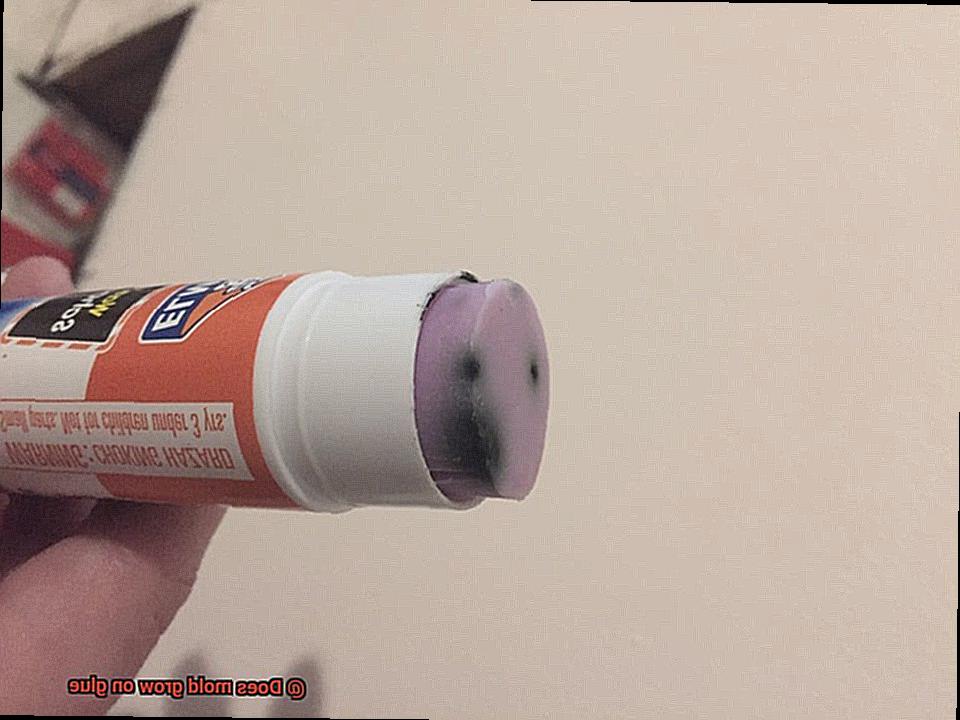
In addition to causing health problems, mold can also damage the surfaces it grows on. It can weaken wood structures and cause fabrics to rot. Moreover, mold can emit an unpleasant odor that’s difficult to remove.
Overall, mold is a serious issue that should not be ignored. If you suspect that you have mold in your home or workplace, it’s important to address the problem immediately to prevent further damage and potential health risks. This means identifying the source of the moisture and fixing any leaks or ventilation issues. You may also need to enlist the help of a professional to remove the mold safely and effectively.
What are the Conditions for Mold to Grow on Glue?
Mold growth on glue is a common problem that can be prevented if you understand the conditions that facilitate its growth. Mold is a sneaky and destructive fungus that can grow on almost any surface, including glue. It thrives in damp and humid environments and spreads its spores through the air like tiny soldiers, waiting to attach themselves to surfaces and wreak havoc. So, what are the conditions for mold to grow on glue? Let’s dive in.
The primary factor for mold growth is moisture. If there is enough moisture or water present, mold spores can grow and thrive on glue. This means that if your glue is stored in a damp or humid environment, you’re at risk of mold growth. Keeping the area clean and dry is essential in preventing mold growth on glue.
Temperature is another critical factor to consider. Mold prefers a warm and humid environment to grow, and the ideal temperature range for mold growth is between 68-86 degrees Fahrenheit. Therefore, storing your glue in a cool place can prevent mold growth.
Additionally, mold needs a food source to grow, and many types of glue contain ingredients that can provide this, such as starch, cellulose, or sugar. The pH level of the glue can also affect mold growth, with a more acidic pH level being more favorable for mold growth.
It’s important to note that not all types of glue are equally susceptible to mold growth. Some types of glue are more resistant to mold growth because they contain antimicrobial agents that inhibit the growth of mold and other microorganisms.
To prevent mold growth on glue, proper ventilation can help reduce humidity levels and prevent moisture buildup. Additionally, storing glue in a cool and dry place can help prevent mold growth. Cleaning up spills promptly and not leaving open containers of glue lying around can also help prevent mold growth.
Types of Glue and Susceptibility to Mold Growth
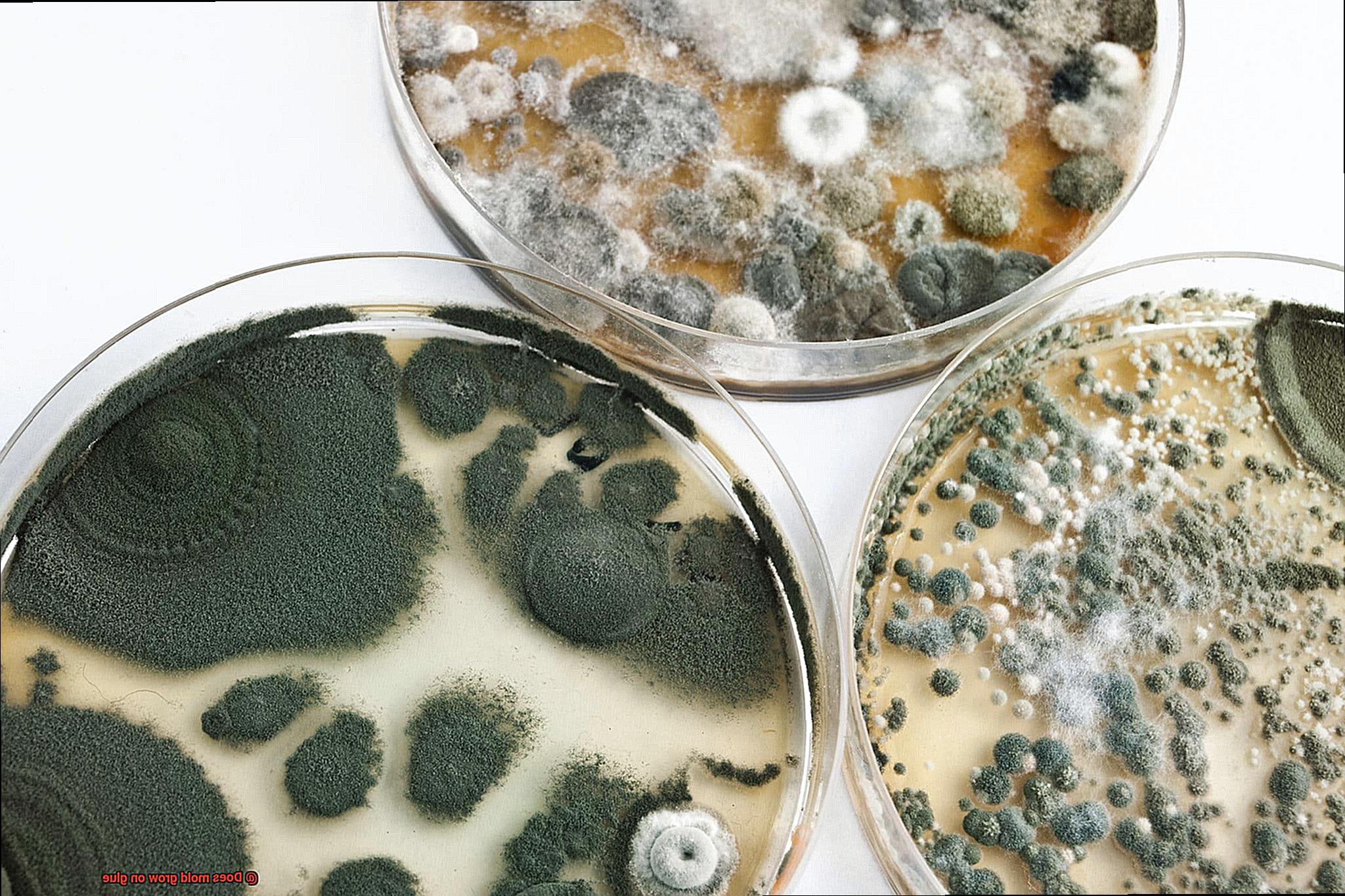
When it comes to the question of whether mold can grow on glue, the answer is not straightforward. The type of glue used can play a significant role in determining whether mold growth is likely to occur. In this article, we will explore the different types of glue available and their susceptibility to mold growth.
Water-Based Glues: The Perfect Environment for Mold
Water-based glues, such as white glue or school glue, are popular for their ease of use and clean-up. However, they are highly susceptible to mold growth. This is because they contain organic compounds that serve as food for mold. Additionally, water-based glues contain more moisture, which provides an ideal environment for mold to thrive.
Organic-based glues such as wood glue and paper glue are also more vulnerable to mold growth due to their composition. These types of glues provide an ideal environment for mold spores to grow and thrive. Additionally, these glues often have extended drying times, which can create a damp environment that promotes mold growth.
Solvent-Based Glues: Resistant to Mold Growth
Solvent-based glues use solvents like acetone or toluene instead of water as a carrier for the adhesive. These types of glues are less likely to support mold growth because they contain fewer organic compounds and less moisture. Solvent-based glues are typically used in industrial settings where high strength and durability are required.
Cyanoacrylate Glue: Quick-Drying and Resistant
Cyanoacrylate glue, also known as superglue, is another type of glue that is less susceptible to mold growth. This glue dries quickly and forms an extremely strong bond. It also has a resistant quality against moisture making it less likely to support mold growth. However, it can be brittle and tends to crack under stress.
Epoxy Resins: Strong and Durable
Epoxy resins are composed of two parts – a resin and a hardener – that must be mixed together before use. These types of glues are incredibly strong and durable, making them ideal for construction and woodworking projects. Epoxy glue creates a strong bond that is resistant to water and other environmental factors, making it less likely to support mold growth. However, they can be expensive and difficult to work with.
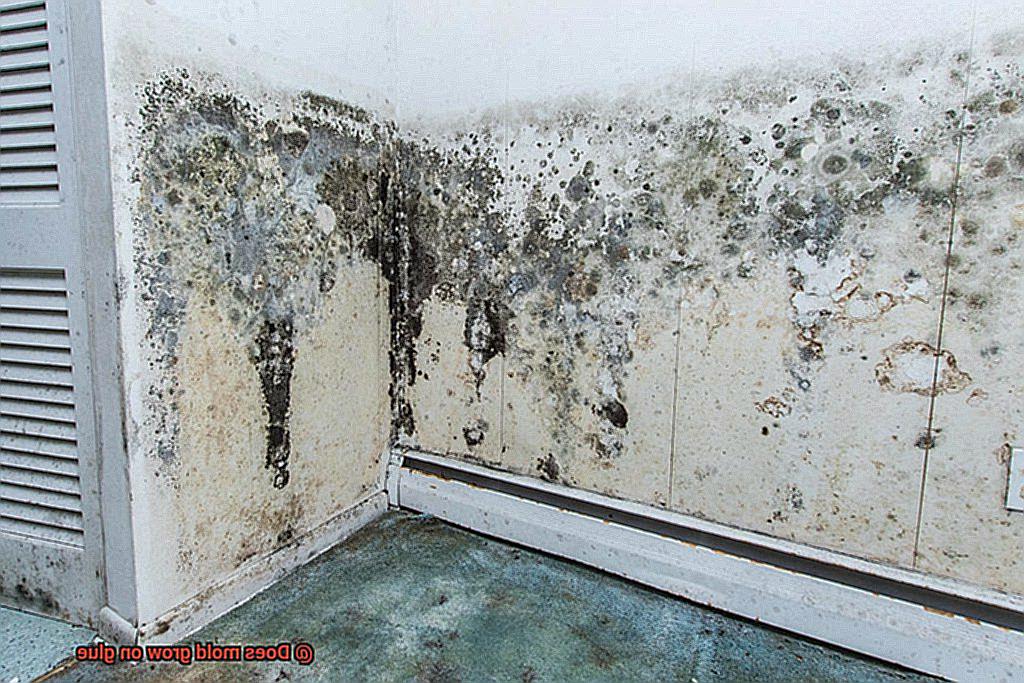
Preventing Mold Growth on Glue
To prevent mold growth on any type of glue, it is important to store the glue in a cool, dry place with proper ventilation. High humidity levels and warm temperatures can create a breeding ground for mold on glue. If you notice any signs of mold on your glue, it is best to discard it as mold can spread quickly and cause health problems.
Temperature and Humidity Affecting Mold Growth
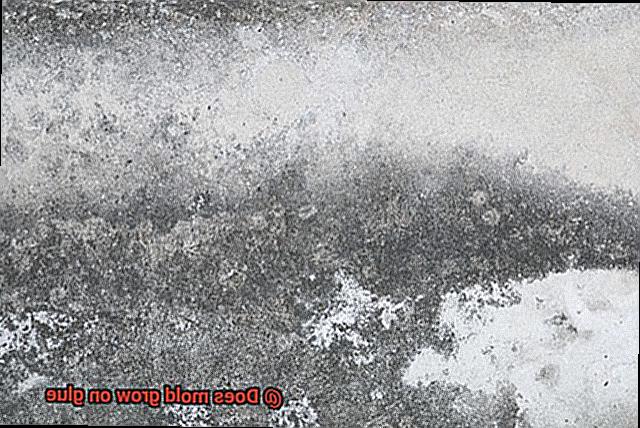
Mold is a pesky problem that can crop up on any surface, including glue, and if left unchecked, it can cause severe damage to your belongings and health. Hence, understanding the role of temperature and humidity in mold growth on glue is crucial.
Let us start with temperature. Mold loves warm, moist environments, and the ideal temperature range for mold growth on glue is between 77°F (25°C) and 86°F (30°C). Within this range, mold spores can germinate and grow rapidly, forming visible colonies on the surface of the glue. However, molds can still grow at temperatures as low as 32°F (0°C) and as high as 122°F (50°C), though growth is slower at these extreme temperatures.
Now let us dive into humidity. Humidity levels also play a significant role in mold growth on glue. Mold requires a relative humidity level of at least 70% to grow and thrive. At lower humidity levels, mold growth slows down or stops altogether. Therefore, it is essential to keep the humidity level below 60% to prevent mold growth.
It’s worth noting that different types of glue have varying levels of susceptibility to mold growth. Organic-based adhesives such as wood glue, paper glue, and animal-based glue are more prone to mold growth than synthetic-based adhesives like cyanoacrylate or epoxy adhesives.
So, how do you prevent mold growth on glue? The best way is to store it in a cool, dry place with proper ventilation. Ensure the humidity level is below 60%, while the temperature should be between 50°F (10°C) and 80°F (27°C). If you notice any signs of mold growth on your glue, dispose of it immediately and clean the affected area thoroughly to prevent further contamination.
Signs of Mold on Glue
Mold is a type of fungus that thrives in warm and damp environments, making glue a prime spot for it to grow if it’s not stored or used correctly.
The first sign to watch out for is the appearance of green, black, or white spots on the surface of the glue. These spots can be small or large and may appear in clusters or spread out across the surface of the glue. If you see these spots, it’s a clear indication that mold has started to grow.
Another telltale sign of mold growth on glue is a musty odor. If you detect an unpleasant smell coming from your glue, it’s time to investigate further. The odor is caused by microbial volatile organic compounds (MVOCs) released during mold growth and should not be ignored.
Mold growth can also change the texture or consistency of the glue. It can cause the glue to become slimy or discolored, and it may also affect its adhesive properties. If your glue no longer seems to be holding materials together effectively, it could be a sign that mold has taken hold.
It’s important to note that not all types of glue are equally susceptible to mold growth. Natural glues made from animal hides or vegetable starches are particularly prone to mold growth. On the other hand, synthetic glues may be less likely to develop mold.
Environmental factors such as humidity and temperature can also contribute to whether or not mold will grow on your glue. If you live in a humid environment or store your glue in a damp area, you may be more likely to experience mold growth.
If you suspect that your glue has mold growing on it, it’s important to act quickly. Mold can cause health problems for some people, particularly those with allergies or respiratory issues. To prevent further mold growth and ensure the safety of your workspace or home, it’s best to dispose of any affected glue and thoroughly clean the surrounding area.
Prevention Strategies for Mold Growth on Glue
Mold growth on glue can be a nightmare for anyone who relies on strong and long-lasting bonds. Not only does it weaken the adhesive, but it can also create an unpleasant musty smell. To avoid this problem, here are some easy and effective prevention strategies.
First and foremost, where you store your glue is crucial. Moisture is one of the main culprits behind mold growth, so it’s important to keep your glue in a cool, dry place. Direct sunlight and high humidity areas like the bathroom or laundry room should be avoided at all costs. You can even use airtight containers to create a barrier that prevents air and moisture from getting in.
To ensure a strong bond, clean surfaces are essential. Before applying glue, make sure the surfaces you’re bonding are clean and free of debris that can contribute to mold growth. Dust and dirt trap moisture, providing a perfect breeding ground for mold. So, take a few extra minutes to clean your surfaces before gluing.
Another great tip is to use anti-fungal agents. Some glues come with these agents built-in, but for those that don’t, adding an anti-fungal agent can help prevent mold growth. These agents work by inhibiting the growth of mold spores on the surface of the glue.
Finally, controlling humidity levels is key in preventing mold growth on glue. Keeping humidity levels below 60% is recommended, especially in areas where you store your glue. You can use dehumidifiers or air conditioning units to regulate humidity levels.
By implementing these strategies, you can keep mold at bay and ensure your glued items remain strong and long-lasting. However, regular inspections of glued items are crucial to prevent further damage if mold growth or weakening adhesion is detected.
yaWoAgwMhEI” >
Conclusion
In conclusion, the possibility of mold growth on glue is not a myth but a reality. The type of glue used, surrounding environment, and frequency of usage play a crucial role in determining the likelihood of mold growth. Organic-based and water-based glues are more prone to mold growth due to their composition, while solvent-based adhesives like cyanoacrylate and epoxy are less likely to support mold growth.
Mold thrives in warm, moist environments with a food source, making proper storage in a cool, dry place with adequate ventilation essential in preventing mold growth on glue. Keeping humidity levels below 60% can also help prevent mold from taking hold.
Signs of mold growth on glue include green, black or white spots on the surface of the glue, musty odor and changes in texture or consistency. To prevent mold from growing on glue surfaces, it’s important to store them properly in cool and dry places with proper ventilation. Before applying glue, ensure that surfaces are clean to avoid debris that can contribute to mold growth.
Using anti-fungal agents can also inhibit the growth of mold spores on the surface of the glue and controlling humidity levels can go a long way in preventing mold from growing.


